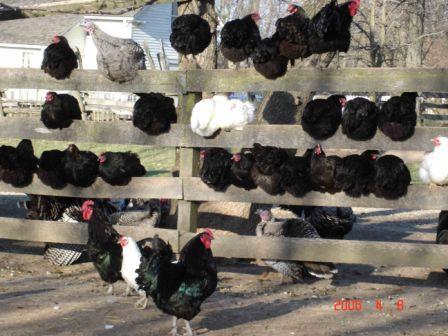|
|
News from Garfield Farm |
Black Java Chicken Project
The history of this ‘‘project” has its roots in the museum’s decision to help preserve the breed. The Black Java first became known in America around the 1830’s and was rumored to have come from the island of Java in Southeast Asia. Although slow growing, it was valued for its meat production and brown eggs. The breed eventually became a very popular market bird in the 1880’s and was used to develop several other birds including the Plymouth Rock, Jersey Giant, and Rhode Island Red. Over the years, the Java was replaced by more productive breeds and by the mid 1990’s, it was rarely seen outside the occasional backyard flock. Only five hundred or so birds remained in the whole country. That was when Garfield Farm decided to help save the breed before it disappeared forever. Our original birds came from Duane Urch’s Hatchery in Minnesota.
When the Museum of Science in Industry in Chicago heard about the plight of the Java, they offered to incubate our Java eggs at MSI as part of the hatchery display in their Genetics Exhibit. Even now, all these years later, Tim Christakos from the MSI still drives out once a week during the season to pick up the eggs and take them back to the city. Thousands of visitors watch them hatch every year at MSI. When the chicks are old enough, Tim brings the best birds back to the museum where they are eventually reintroduced to the flock. Others are shipped around the country to individuals that want to help save the breed.
In 1999, there was a surprise when a white Java was hatched out of Garfield’s flock. No one had seen a White Java since they had disappeared over forty years before. Whether this initial bird was the result of inbreeding or whether it came from a gene that had lain dormant in the flock, we’ll never know. Since then, the farm has kept White Javas as well. Auburn Javas have also emerged, but are no longer raised at the farm.
In May 2008, the museum began a well structured breeding program with help from Don Schrider of the American Livestock Breeds Conservancy. The goal was to improve the qualities of the flock and to get the birds closer to the Standards of Perfection set by the American Poultry Association. Lead “scientist” for the project was Bill Wolcott, who had only been on staff for a few weeks and had never worked on a farm. Assisting him in this endeavor was museum staff member, Dave Bauer, who had at least held a chicken. It was hoped his background in computer hardware engineering would somehow translate into engineering chickens.
The birds with the best physical traits were selected and taken over to Mongerson where they were housed in wooden pens, each with one rooster and several hens. To combat inbreeding, older birds were crossed with younger ones. However, it soon became evident that the recessive gene that produced the white feathers had become too prevalent among the Black Javas. This resulted in too many Black Java pairings producing white birds. Eventually, through a lot of trial and error, the staff was able to identify birds without the white gene. These were crossed last year with additional birds from Duane Urch and molecular biologist and Java enthusiast, Jim Ward from Ohio. This resulted in Black Javas without the recessive gene and which had some new blood to help counter any inbreeding. Now the focus of the program has shifted back to improving the bird’s physical qualities in an effort to make them more marketable. The White Java Flock is kept at Mongerson through the egg laying season to keep them from interbreeding with the Black Java and spreading the recessive gene.
All this work with Javas, is very important for the long term preservation of the breed, but it requires a lot of staff time and feed costs have gone up substantially. If you would like to help support the program, please consider a monetary donation to help cover some of the costs of the program or consider volunteering to help work with our little feathered friends. Don’t worry, lead aprons are not required and you can leave your Geiger counter at home.
